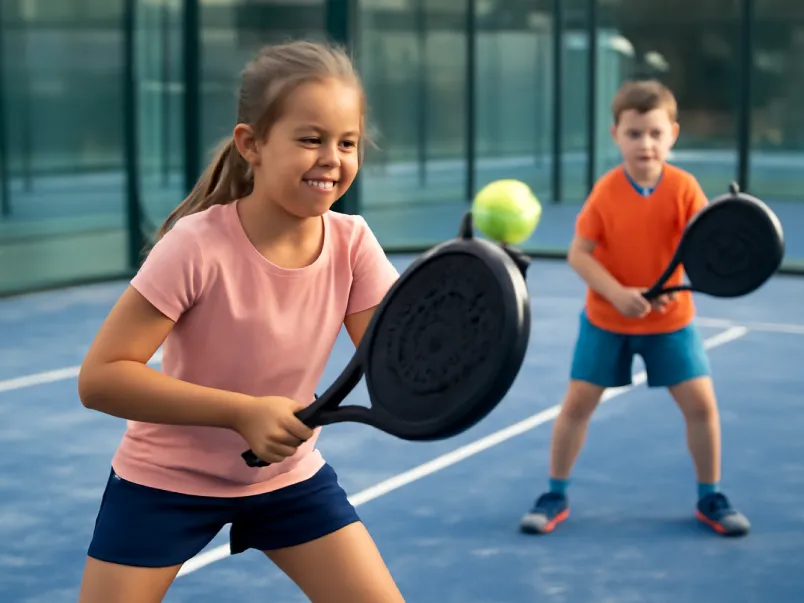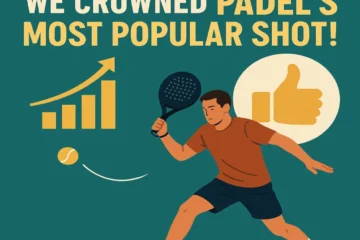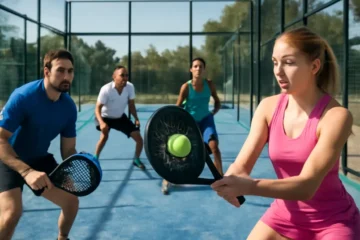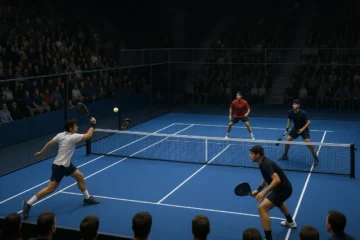Have your kids ever told you that football or cricket feels “too competitive,” or that tennis looks fun but a little hard to start? Many parents are searching for the perfect sport that’s safe, fun, and easy to learn — one that encourages activity while also building friendships. That’s where padel for kids comes in.
Imagine a mix of tennis and squash, played on a smaller court with walls that keep the ball in play. That’s padel — a fast-growing sport around the world, and one that’s perfectly suited for children. It’s less intimidating than traditional racket sports, yet it delivers the same physical, mental, and social benefits.
In this guide, we’ll walk you through why padel is one of the best sports for children, the step-by-step process of getting them started, and tips to make sure they keep loving the game for years to come.
Section 1: Why Padel is a Fantastic Sport for Kids
Parents want to know why padel stands out from other sports. Here’s a breakdown of its unique advantages for children.
Subsection 1.1: Physical Benefits
1. Full-Body Workout
Padel is more than just hitting a ball back and forth. Kids will constantly move, jump, twist, and swing, giving them a full-body workout. The dynamic nature of padel develops coordination, agility, and quick reflexes, which are essential for their overall growth.
2. Improves Motor Skills
Children need activities that sharpen their hand-eye coordination and spatial awareness. Padel helps kids track the ball, adjust to its bounce off walls, and control their movements — skills that carry over to other sports and daily activities.
3. Boosts Fitness
Padel matches are energetic, keeping kids running and moving without them even realizing it. It’s an excellent cardiovascular workout that builds stamina, endurance, and core strength, promoting long-term fitness.
4. Low-Impact Sport
Unlike high-contact sports such as football or basketball, padel puts less strain on young joints. Its smaller court and lighter equipment make it gentler on the body, reducing the risk of overuse injuries common in other youth sports.
Subsection 1.2: Mental & Social Benefits
1. Fun and Engaging
Padel is a sport where rallies last longer, thanks to the walls that keep the ball in play. For kids, that means more action, more laughs, and fewer moments of frustration.
2. Boosts Confidence
Even beginners can get the ball over the net within their first session. These small wins build self-esteem and encourage kids to keep improving.
3. Teaches Teamwork
Since padel is mostly played in doubles, children learn how to communicate with partners, plan strategies, and celebrate shared victories. This teamwork aspect is invaluable for their social development.
4. Develops Strategic Thinking
Padel isn’t just about hitting hard; it’s about anticipating the ball’s path, reading opponents, and placing shots smartly. Kids naturally pick up problem-solving and critical thinking while having fun.
5. Reduces Screen Time
Parents today are looking for ways to limit their child’s screen use. Padel provides an exciting alternative that gets them moving, socializing, and staying healthy.
Section 2: Getting Started – A Step-by-Step Guide for Parents
Now that you know why padel is great for children, let’s explore how to get your child started on their padel journey.
Subsection 2.1: Is My Child Ready for Padel?
Age:
- Kids as young as 4–6 years old can start with fun, modified games that focus on movement and coordination.
- From around 7–8 years old, they can join more structured lessons and begin to grasp the rules.
Interest & Attention Span:
The key factor is your child’s desire to play. If they’re curious, eager to swing a racket, or simply love running around, they’re ready for padel.
Subsection 2.2: Finding the Right Equipment
1. The Padel Racket
Children need rackets specifically designed for them:
- Lightweight and small-grip rackets prevent strain.
- Avoid heavy adult rackets, as they can cause bad habits or even injuries.
2. Balls
Padel balls are slightly softer and less pressurized than tennis balls, which makes them slower and easier for kids to control.
3. Shoes & Clothing
- Comfortable, breathable sportswear is best.
- Proper court shoes with non-marking soles provide grip and protect against slipping.
- Avoid running shoes, as they don’t offer the same lateral stability needed on padel courts.
Subsection 2.3: Finding a Club and a Coach
1. Look for a Padel Club
Many cities now have padel clubs offering junior programs. Search online for “Kids Padel classes near me” or check local sports centers.
2. Importance of a Good Coach
A coach experienced with children can make the difference between a child enjoying padel or giving up quickly. They’ll focus on proper technique while keeping sessions lighthearted and fun.
3. What to Look For in a Class
- Small group sizes (so each child gets attention).
- A fun, engaging structure with drills and mini-games.
- Positive coaching that celebrates progress instead of only correcting mistakes.
Section 3: Keeping it Fun – The Key to Long-Term Love for the Sport
Children thrive when activities are enjoyable. Here’s how parents can help maintain their enthusiasm for padel.
1. Focus on Play, Not Perfection
Your child doesn’t need to be a padel star overnight. Prioritize fun, exploration, and joy, rather than performance or competition.
2. Keep Sessions Short and Sweet
Younger kids have shorter attention spans. Start with 20–30 minutes, then gradually increase as they grow older and more interested.
3. Celebrate Small Victories
Did your child return a tricky ball? Did they remember to encourage their partner? Celebrate these wins — they keep kids motivated.
4. Play with Them
Padel is one of the few sports that adults and children can enjoy together, regardless of skill. Joining your child on the court creates bonding moments they’ll remember forever.
5. Avoid Early Specialization
Sports experts warn against focusing on one sport too early. Encourage kids to enjoy padel alongside football, swimming, or dance — variety keeps them active and balanced.
Section 4: Frequently Asked Questions (FAQ)
Q1: How is padel different from tennis for a child?
Padel is played on a smaller court, with walls that keep the ball in play longer. It’s less technical at the start, easier to rally, and more social since it’s usually played in doubles.
Q2: Is padel a dangerous sport?
Not at all. Padel is considered one of the safest racket sports. With proper supervision and the right equipment, the risk of injury is minimal.
Q3: What if my child has never played racket sports before?
Perfect! Padel is known as a beginner-friendly sport. Many kids rally successfully during their first class, which builds excitement right away.
Q4: How much does it cost to get started?
Costs vary by location, but here’s a rough estimate:
- Junior padel racket: $40–$70
- Balls: $10–$15 per pack
- Court rental/class fees: $15–$40 per session
This makes padel comparable to — or sometimes cheaper than — sports like tennis, swimming, or martial arts.
Conclusion
Padel isn’t just another sport; it’s an opportunity for children to grow physically, mentally, and socially. With its beginner-friendly rules, safe environment, and focus on fun, padel offers a healthy balance of exercise, teamwork, and self-confidence.
For parents, it’s not just about teaching kids a sport — it’s about opening the door to an active lifestyle, meaningful friendships, and lifelong memories.
So, grab a racket, find a local club, and let your child step onto the padel court. Their first smile after hitting the ball will tell you everything you need to know: they’re hooked.
Faqs
Q1: What is padel for kids?
Padel for kids is a child-friendly version of the sport combining tennis and squash. It’s easy to learn, fun to play, and designed to build fitness, confidence, and social skills.
Q2: At what age can kids start playing padel?
Children can begin with playful, modified padel games as early as 4–6 years old. More structured training usually starts around ages 7–8.
Q3: What equipment does my child need for padel?
Kids need a lightweight padel racket, low-pressure padel balls, and proper non-marking shoes for safety and grip. Comfortable sports clothing is also recommended.
Q4: How is padel different from tennis for children?
Padel has a smaller court, uses walls to keep the ball in play, and is usually played in doubles. This makes it easier, more social, and beginner-friendly.
Q5: Is padel safe for kids?
Yes. Padel is considered a low-impact, safe sport. With proper equipment and supervision, the chances of injury are minimal compared to contact sports.
Q6: How much does it cost to get started with padel for kids?
Starting costs are reasonable: a junior racket ($40–70), balls ($10–15), and club or lesson fees (about $15–40 per session). Prices vary by location.
Q7: Can kids who have never played racket sports learn padel?
Absolutely. Padel is known for being easy to pick up. Even complete beginners usually rally within their first session, boosting confidence quickly.




